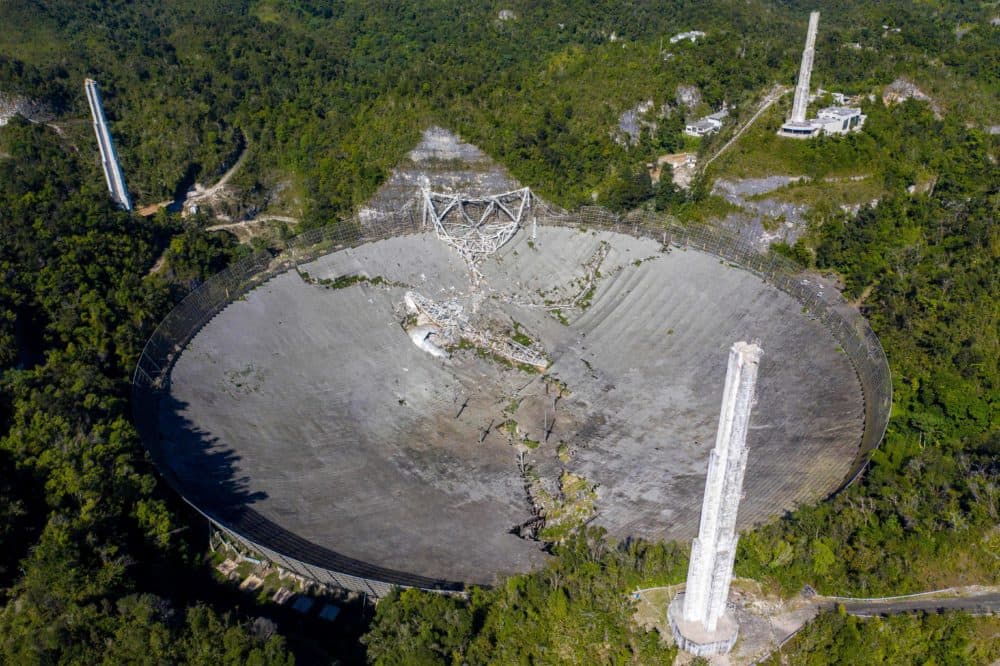Advertisement
Collapse Of World-Renowned Arecibo Telescope In Puerto Rico Shocks Astronomers

In the final scene of “GoldenEye,” James Bond chases a villain onto a giant dish antenna, where a receiver suspended 450 feet above falls on top of the bad guy and explodes.
The scene was shot at the Arecibo Observatory in Puerto Rico, and on Tuesday, the giant radio telescope came crashing down. No one was hurt in the collapse, but just two weeks ago, officials warned the telescope needed to be dismantled because two cables suspending it had snapped, one in August and one in November.
Astronomers around the world like Harvard University’s Alyssa Goodman are heartbroken by the news. Goodman wrote much of her thesis at Arecibo 30 years ago and has fond memories of the famed telescope.
The large Arecibo Observatory gave students hands-on opportunities to use a telescope, she says. Goodman used to build the radio telescope’s receiver with coaxial cables — and calculated that the National Science Foundation was paying $40,000 per day in maintenance at the time.
“I thought, ‘Oh my God, they're giving this know-nothing graduate student a telescope that costs $40,000 a day to operate.’ ” she says. “But in the end, we found the first measurement of a magnetic field in a particular kind of region in space that's very important because it formed stars. And so that's the kind of thing that happens at Arecibo.”
The facility looked even more impressive in person than in photos, Goodman says. She used to jog and walk more than 3,000 feet around the rim of the telescope with colleagues, surrounded by jungle growing on limestone karst.
The facility resembled something out of “Jurassic Park” more than any of the movies people may remember seeing it in, she says. And one time, Goodman hung from a rope to retrieve a pencil that had dropped into the telescope — a story she says her mother didn’t enjoy hearing.
Astronomers need another telescope like Arecibo, Goodman says. China’s FAST telescope attempts to do the same kind of work, but it’s yet not the same quality in terms of sensitivity and reliability, she says.
As astronomers mourn this professional loss, many will remember the telescope for its appearances in movies such as the 1997 sci-fi film “Contact,” where Jodie Foster searches for alien life out in the galaxy. Jill Tarter, the real astronomer the movie is based on, is a friend of Goodman. The two have been consoling each other on Twitter about this personal and scientific loss.
Advertisement
For Goodman, it’s shocking that a telescope of such magnitude and importance deteriorated to the point of collapse.
“The idea that two weeks ago people were saying this was unsalvageable and then it took only two weeks to actually collapse is kind of unbelievable,” she says. “But it happened.”
Many people don’t realize the important role Arecibo plays in science education efforts in Puerto Rico, she says. A staff member worked for 20 years to create a visitors center that’s essential in teaching young people and adults on the island.
The NSF needs to keep the educational aspect of Arecibo alive, she says.
“Arecibo is leaving us a beautiful legacy of science,” she says, “and hopefully we'll get something to replace it soon.”
Julia Corcoran produced and edited this interview for broadcast with Tinku Ray. Allison Hagan adapted it for the web.
This segment aired on December 2, 2020.

